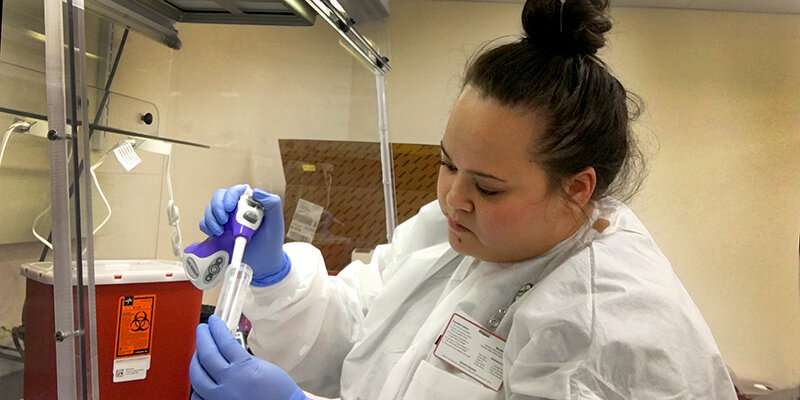Diana Gerrard G ’19 helps develop a new process for testing COVID-19 samples in the UVM Medical Center’s genomic medicine department. Credit: University of Vermont
A shortage of COVID-19 test kits and the need for broader testing in Vermont has mobilized a task force of researchers from UVM College of Nursing and Health Sciences, Larner College of Medicine, Vermont Integrative Genomic Resource and the University of Vermont Medical Center. The scientific team is working to bridge the gap in available test supplies in Vermont and nationwide by developing new methods of testing patient samples and sharing their new workflows with other scientists and labs.
UVM alumna Diana Gerrard, a medical laboratory scientist in UVM Medical Center's genomic medicine department, is a critical task force team member. An expert on molecular pathology, Gerrard graduated from UVM in 2019 with a doctorate in Cellular, Molecular and Biomedical Sciences.
We talked with Gerrard about her work and how laboratory scientists in Vermont contribute valuable knowledge in the race to stop the spread of the disease.
How did you become involved in perfecting COVID-19 testing?
As the need for COVID-19 testing increased in our community, we knew that we needed to be ready at the frontlines of testing. We also knew that we needed to think critically and creatively about how we would test people as we faced shortages in testing kits.
In my role at UVM Medical Center, I evaluate and validates new assays (tests for measuring the components of a substance or sample). My usual work involves investigating assays surrounding cancer. These assays allow us to determine specific genetic mutations underlying a person's cancer, which can inform a more specific clinical care plan for their treatment. While I do not usually work with viruses, the tests used to screen COVID-19 are molecular-based assays and my leaders brought me on the local task force to utilize my expertise in molecular biology and familiarity with assay evaluations and validations for the medical center.
Please describe the work you are now doing.
In general, the COVID-19 test can be broken up in two parts: the first step involves extraction of the viral material from the patient samples collected. The second step is to detect the COVID-19 viral genome, the specific genetic sequences that give the virus its identity.
Our team of researchers identified an alternative resource to use for the first step that would allow us to work around the shortage of extraction kits. My role has been validating this change in the clinic and piecing that together with different methods for step two. This involves implementing the workflow in our clinical laboratory—getting the space, resources and instrumentation up and running in order to perform the testing—and performing a validation process that allows us to determine our limit of detection (the lowest amount of virus detected in a given sample).
How does your work contribute to tests used nationwide?
There has been a national shortage of testing kits using the Center for Disease Control's method, so our group published a preprint of the changes we made to the first step of the process. This change uses kits widely available in a majority of biomedical science research laboratories, and clinical groups have contacted us to inquire about our workflow and clinical evaluation of these kits.
Laboratory scientists working on COVID-19 nationally have formed a collaborative community. We are working hard and fast while maintaining high standards in our testing and so we have relied on each other to give feedback during both the trials and successes of testing.
How did your education prepare you for this work?
I completed my Ph.D. in the Cellular Molecular Biomedical Sciences program in the laboratory of Dr. Seth Frietze in the Biomedical and Health Sciences Department at the College of Nursing and Health Sciences. I developed my molecular biology expertise during my Ph.D., and this has trained me for the technical responsibilities during the COVID-19 response. Additionally, my doctoral training has allowed me to develop the rigor needed to work actively for long hours and think critically and collaboratively.
Does your work put you at risk for contracting COVID-19?
All of us working on the front lines of the response to COVID-19 are at risk for contracting the virus; however, serving our community is exactly what fuels us. We are sure to take appropriate and careful measures while working with the virus by wearing appropriate personal protective equipment. Additionally, we are sure to take the same precautions regarding hand hygiene as everyone else in our work and home life, not only to stay well for ourselves but also so that we can continue to serve and support our community.
Provided by University of Vermont























